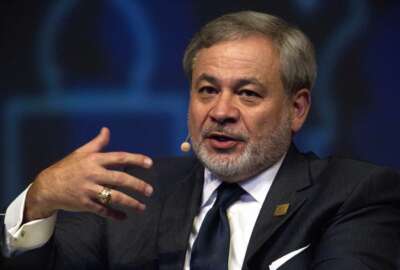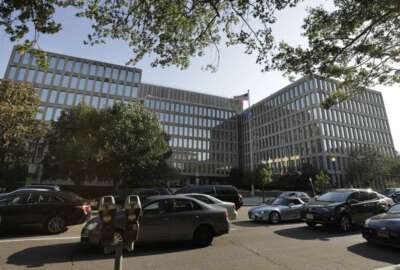
Do agency plans for reentry go far enough?
American University professor Bob Tobias joined the Federal Drive with Tom Temin to share his thoughts on how the federal government should reopen its physical...
Best listening experience is on Chrome, Firefox or Safari. Subscribe to Federal Drive’s daily audio interviews on Apple Podcasts or PodcastOne.
Do federal agencies have strategic change processes in place to have people return to their offices? Well, sort of. But my next guest doesn’t think the published, three-phase plans go far enough. For the latest strike of the gadfly, the Federal Drive with Tom Temin spoke to American University professor Bob Tobias.
Interview transcript:
Tom Temin: Bob, you’ve been sort of poking at this whole process all the time, now, return to the offices. Tell us your problem with how agencies are planning this.
Bob Tobias: Tom, I think that what has happened with agencies closing and will be happening with agency reopening, constitutes a continuing significant change in the way work is organized and performed, particularly at home. And that change can be managed either proactively or reactively. And so far, it has been managed reactively: Agencies shut down; they’ve create new rules. They tried to make things happen, but it was all reactively. And now, they have a chance with agencies reopening, to think strategically, and what the impact will be. But what I see is patchwork, again, responsive, again, as opposed to being proactive about how to do the agency’s work, both safely and productively. And more importantly, what do I have to do as a leader to lead in this new world? There is very little, if any, thinking about any of that.
Tom Temin: Now, Bob, the agencies do have these three-phase plans, depending on how many people with cases and the outbreaks, and they’re tied to local conditions depending on where the particular federal office is. So there is some planning process for getting people back in the offices. But what’s your problem with those plans?
Bob Tobias: Well, the plans are patchwork and the CDC has put out some new requirements about providing temperature checks and distancing and working in shifts. And they say that people should wear masks. Now the agencies are all over the place on how they’re going to go back to work, and that’s the safety question. And that needs to be solved. There needs to be certainty around it. But it can’t be outside of the total context of how do I manage in this new environment? And that, I think, is being ignored.
Tom Temin: Because besides these return plans based on the three-phase planning idea, there’s also longstanding telework policies, which get twisted and put in and taken out and expanded and contracted. But it seems like if you have a policy for working outside of the office, and you have this return plan, somehow there should be an integration, maybe.
Bob Tobias: Exactly. Exactly, Tom. I’m going to lead differently if half of my workforce is in the office, and half is out of the office. I’m going to lead differently if everybody is outside of the office. I’m going to have to have more conversations if everybody’s outside. I’m going to have to pay attention that I only talk to the people who are inside and ignore the people who are on the outside. Safety is important. It’s critically important, but the other aspect of getting the work done also can’t be ignored. And if I’m a leader, and I’m unwilling to change, then those I lead will also be unwilling to change.
Tom Temin: We’re speaking with Bob Tobias, a professor in the Key Executive Leadership Program at American University. And you also have some ideas for other elements that need to be in place physically, for the people that are back in the offices.
Bob Tobias: Yes. And as the CDC said, there should be shields around the cubes. There should be temperature checks. There should be distancing, seating, barred and common areas, masks at all times. And that should be everywhere. It shouldn’t be just ad hoc, as an agency might determine. Those protections should be standard. They should be everywhere, so that people feel safe. How can I work productively, thoughtfully, creatively, if I don’t feel safe?
Tom Temin: And of course, you and I both remember the so-called “old days” when people could walk into any federal building, knock on a door and chat with someone. Over the decades, the perimeter has gotten further out and much tighter. But nevertheless, there is the requirement for lots of people to visit federal offices all the time and to get together with people–vendors, whatever the case might be. What’s your thoughts on how they should incorporate the need for having outsiders come in?
Bob Tobias: I think it’s going to be very difficult for the government to deal with that issue. I think the first issue, Tom, is employees and the focus should be on employees. And vendors–vendors can do Zoom, or whatever the platform is, until there’s some agreed upon and settled way of keeping employees safe. I think that should be the first focus, and contractor interchange, second.
Tom Temin: All right. So what do you think should happen next now? Because, the plans are starting to be rolled out–I’m not sure anyone’s actually returning to the office in any large numbers. By the way, I like to define the terms, and we’re all using all these different words. The government has not stopped working throughout this whole pandemic. They’ve been working harder than ever. They just haven’t been in the office.
Bob Tobias: Well, you know, what’s interesting about that, Tom, is that with this telework, most agencies who have paid attention have had increased productivity during this period of time, not decreased productivity. So as you point out, the government has been working, but just as important, more effectively than it has in times past. So, now, that uncertainty has been solved, and now we have a new set of uncertainties about reintegration back into the workplace. And, as I suggest, as a leader, how do I behave differently? And I think that also, ought to be the focus of these plans for opening up agencies.
Tom Temin: Sounds like there are lessons learned being produced even as we speak, but nobody is picking them up and gathering them and making use of them for the future.
Bob Tobias: I fear that, Tom. I really fear that, that the focus is on going back to normal. We can never go back to whatever was prior to the closing of agencies. We’ve learned too much. We’ve experienced too much. We can never go back to that. So the question is, are we going to chart our future proactively or reactively? And I hope it’s proactive.
Tom Temin: Bob Tobias is a professor in the Key Executive Leadership Program at American University. As always, thanks so much.
Bob Tobias: Thank you, Tom.
Copyright © 2025 Federal News Network. All rights reserved. This website is not intended for users located within the European Economic Area.
Tom Temin is host of the Federal Drive and has been providing insight on federal technology and management issues for more than 30 years.
Follow @tteminWFED





